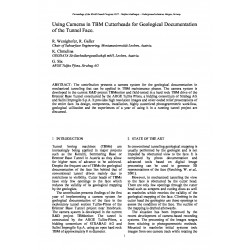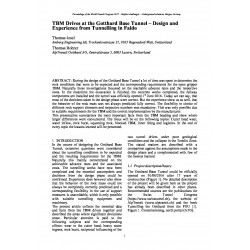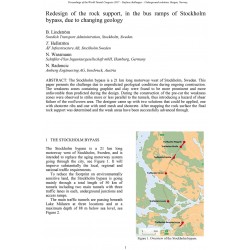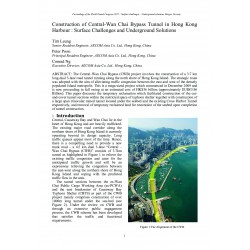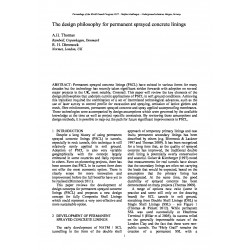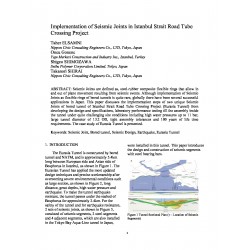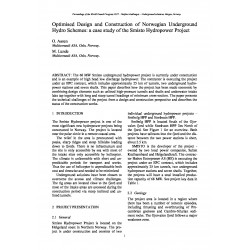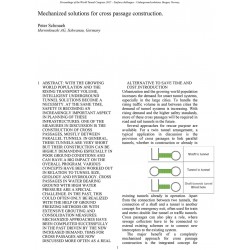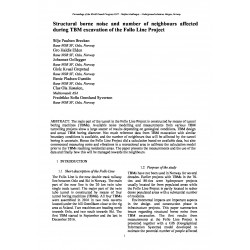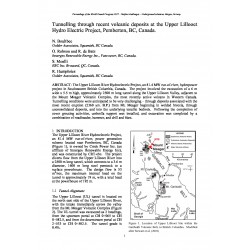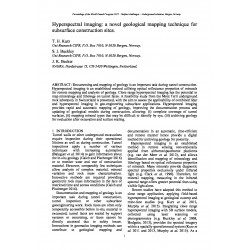No document
Search & filter
Search for a publication
Search & filter
World Tunnelling Congress
WTCThere are 1984 documents.
-
Using Cameras in TBM Cutterheads for Geological Documentation of the Tunnel Face
Abstract: The contribution presents a camera system for the geological documentation in mechanized tunneling that can be applied in TBM maintenance phases. The camera system is developed in the current R&D project TBMonitor and field-tested in a hard rock TBM drive of the Brenner Base Tunnel constructed by the ARGE Tulfes Pfons, a bidding consortium of Strabag AG and Salini Impregilo S.p.A. It provides...
0,00 € -
TBM Drives at the Gotthard Base Tunnel – Design and Experience from Tunnelling in Faido
Abstract: During the design of the Gotthard Base Tunnel a lot of time was spent to determine the rock conditions that were to be expected and the corresponding requirements for the open gripper TBM. Naturally these investigations focussed on the reachable advance rates and the respective costs. In the meantime the excavation is finished, the concrete works completed, the railway components are installed...
0,00 € -
Solving the Challenges of the Santoña-Laredo General Interceptor Collector
Abstract: The Santoña–Laredo General Interceptor Collector is a 1.5 km subsea tunnel currently under construction in northern Spain and part of the Santoña Marshlands Sanitation Project. It is constructed with a 4.30 m Mixshield TBM, assembled in the tight space of a 12 meter diameter shaft located in an urban area, using fibre reinforced concrete segments. The tunnel excavation passes through two...
0,00 € -
Redesign of the rock support, in the bus ramps of Stockholm bypass, due to changing geology
Abstract: The Stockholm bypass is a 21 km long motorway west of Stockholm, Sweden. This paper presents the challenge due to unpredicted geological conditions during ongoing construction. The weakness zones containing graphite and clay were found to be more prominent and more unfavorable than predicted during the design. During the construction of the pre-cut the weakness zones were observed to strike...
0,00 € -
Construction of Central-Wan Chai Bypass Tunnel in Hong Kong Harbour : Surface Challenges and Underground Solutions
Abstract: The Central–Wan Chai Bypass (CWB) project involves the construction of a 3.7 km long dual 3-lane road tunnel running along the north shore of Hong Kong Island. The strategic route was adopted with the aim of alleviating traffic congestion between the east and west of the densely populated Island metropolis. This is a mega-sized project which commenced in December 2009 and is now proceeding in...
0,00 € -
The Joberg tunnel: successful tunnelling in moraine
Abstract: A 100 meter long tunnel in mixed face moraine and rock, below the ground water level, was the solution when the southern end of the Joberg tunnel had to be located in an area with high risk of rock fall. The rock fall risk from the steep mountain side was evaluated to be so high that an open cut was not an option. Since a rail tunnel in clay was constructed in Trondheim in 1942, using...
0,00 € -
Evaluation of the Compressible Gasket Design and Performance for Steel Segments of Bored Tunnels
Abstract: This paper discusses a very unique research including the design and testing of the compressible type gaskets for steel segments, which has not been studied much in the field of the TBM tunneling. Over the course of developing the design of segments of steel rings or flexible rings of the bored tunnels for Eurasia Tunnel, it was discovered that gaskets do not have sufficient space to expand...
0,00 € -
The design philosophy for permanent sprayed concrete linings
Abstract: Permanent sprayed concrete linings (PSCL) have existed in various forms for many decades but the technology has recently taken significant strides forwards with adoption on several major projects in the UK, most notably, Crossrail. This paper will review the key elements of the design philosophies that underpin current applications of PSCL in soft ground conditions. Achieving this transition...
0,00 € -
Implementation of Seismic Joints in Istanbul Strait Road Tube Crossing Project
Abstract: Seismic Joints are defined as, steel-rubber composite flexible rings that allow in and out of plane movement resulting from seismic events. Although implementation of Seismic Joints as flexible rings of bored tunnels is quite rare, globally there have been several successful applications in Japan. This paper discusses the implementation steps of two unique Seismic Joints of bored tunnel of...
0,00 € -
Optimised Design and Construction of Norwegian Underground Hydro Schemes: a case study of the Smisto Hydropower Project
Abstract: The 68 MW Smisto underground hydropower project is currently under construction and is an example of high head low discharge hydropower. The contractor is executing the project under an EPC contract, which includes approximately 25 km of tunnels, two underground hydropower stations and seven shafts. This paper describes how the project has been made economic by combining design elements such as...
0,00 € -
Mechanized solutions for cross passage construction
Abstract: With the growing world population and the rising transport volume, intelligent underground tunnel solutions become a necessity. At the same time, safety is becoming an increasingly important aspect in planning of these infrastructures. One of the measures in discussion is the construction of cross passages, mostly between parallel tunnels. In general, these tunnels are very short but their...
0,00 € -
Structural borne noise and number of neighbours affected during TBM excavation of the Follo Line Project
Abstract: The main part of the tunnel in the Follo Line Project is constructed by means of tunnel boring machines (TBMs). Available noise modelling and measurements from various TBM tunnelling projects show a large scatter of results depending on geological conditions, TBM design and actual TBM boring diameter. Not much reference data from TBM excavation with similar boundary conditions is available, and...
0,00 € -
Tunnelling through recent volcanic deposits at the Upper Lillooet Hydro Electric Project, Pemberton, BC, Canada
Abstract: The Upper Lillooet River Hydroelectric Project, an 81.4 MW run-of-river, hydropower project in Southeastern British Columbia, Canada. The project involved the excavation of a 6 m wide x 5.5 m high, approximately 2500 m long tunnel along the Upper Lillooet Valley, adjacent to the Mount Meager Volcanic Complex, the most recently active volcano in Western Canada. Tunnelling conditions were...
0,00 € -
Passage of a precast segment lining tunnel through an active fault - Special segments and details – Thessaloniki metro
Abstract: Along the track of Thessaloniki Metro, the two precast segment lining tunnels pass through an active fault named “Philaya”. According to the available data from scientific bibliography, (most important: Pitilakis and associates, 2014 expertise report), the fault plane is assumed to cross the longitudinal tunnel axis perpendicularly, under a dip angle of 60° or 70°. The potential coseismic...
0,00 € -
First filling of hydraulic tunnels of Venda Nova III hydropower scheme
Abstract: Venda Nova III reversible hydroelectric power scheme presents features that make it an interesting case study. Worth mentioning are the slope and the length of the 12 m diameter unlined hydraulic circuit, the high water head, the great depth of the powerhouse cavern and the proximity to the hydraulic circuit of Venda Nova II. In this type of projects, the main effect of the internal water...
0,00 € -
Hyperspectral imaging: a novel geological mapping technique for subsurface construction sites
Abstract: Documenting and mapping of geology is an important task during tunnel construction. Hyperspectral imaging is an established method utilising optical reflectance properties of minerals for remote mapping and analysis of geology. Close range hyperspectral imaging has the potential to map mineralogy and lithology on tunnel faces. A feasibility study from the Mont Terri underground rock laboratory...
0,00 €

